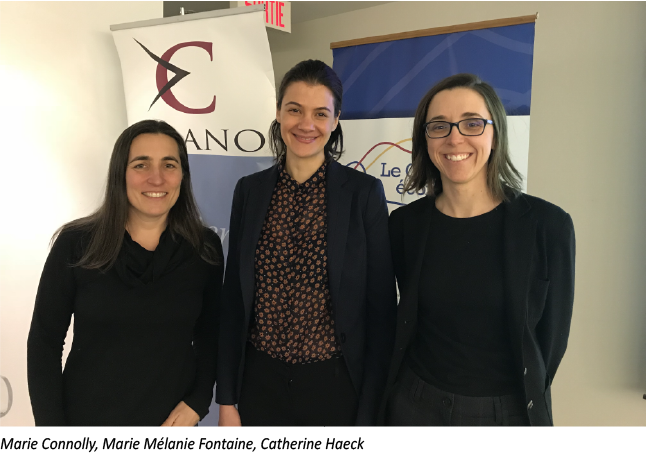© 2025 CIRANO. All rights reserved.
20 March 2018
CIRANO Seminar on salary differences between mothers and women without children in Canada and in the province of Quebec

Marie Connolly, Catherine Haeck, both CIRANO Fellows and Professors at the Université du Québec à Montréal, and Marie-Melanie Fontaine, Postdoctoral Researcher at the Université du Québec à Montréal, published on March 19, 2018 a new CIRANO study on the gaps in revenue between mothers and women without children in the province of Quebec.
The differences in salary between men and women are well documented. The penalties linked to maternity or paternity (i.e. revenue gaps between parents and childless individuals) are less known, but nevertheless remain preoccupying. As the Quebec government adopted a family policy amongst the most generous in the world, it is nevertheless interesting to show the current state of the situation.
During a lunch seminar at CIRANO on March 19, 2018, the authors presented the main prominent facts of their research. The presentation allowed to bring up elements of response to the few questions that follow:
- What is the salary gap between mothers and women without children in the province of Quebec and in the rest of Canada?
- Does the penalty affect certain groups of women in a different manner?
- Does a correlation exist between the province of residence (Quebec vs the rest of Canada) and the magnitude of the penalty tied to maternity?
- Does a salary gap exist between fathers and men without children in the province of Quebec compared to the rest of Canada?
Main prominent facts of the study
- The penalty tied to maternity is generally lower in Quebec than in the rest of Canada. The mothers of the rest of Canada earned on an average 6.3% less than the women without children, all things being equal, experience wise, weekly hours worked, and age (being 2.5% less in the province of Quebec).
- Does the penalty affect certain groups of women in a different manner? For the province of Quebec, the difference in revenue is noteworthy when we look at particular sub-groups.
Mothers who have a lower level of education (the penalty is 8.8%) and single-parent mothers (the penalty is 10.9%), two groups that are already more at risk of heading towards the poverty line and social exclusion, are submitted to maternity penalties.
No matter which province we are referring to, the gaps in revenue increase as the number of children grows, the penalties being increasingly heightened. Therefore, for Quebec mothers who have 3 children or more, the gaps in revenue are in the order of 10 to 23%. - If we analyze the scales of employment revenue of mothers after the birth of their first child, comparing to the revenue of women without children, the Quebec mothers seem again favored compared to the mothers of the rest of Canada. In fact, the mothers of Quebec recover revenue levels alike women without children after 4 years, compared to 12 years in the rest of Canada.
- The men’s situation seems to be the reverse: fathers have on average a higher revenue than men without children. However, Quebec or anywhere else in Canada fathers, either in the province of, do not see their revenue increase after the birth of their first child. These results suggest that fathers and men without children differ according to visible and invisible characteristics, and that those characteristics would be the basis of the revenue differences. Therefore there would be no bonuses tied to paternity, but rather a differential selection between fathers and men without children.
The body of results is evidence of a correlation between the province of residence and the magnitude of the penalty tied to maternity. However, the situation in the province of Quebec is, in many aspects, better than in the rest of Canada. It is possible that the family policies in Quebec (subsidy to daycare services and to parental leave), in spite of the unofficial acceptance of such, help the mothers maintain an attachment to the work force and a level of revenue that is more in line with the revenue of women who have no children.